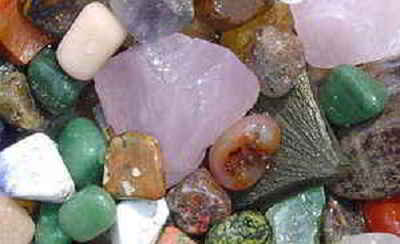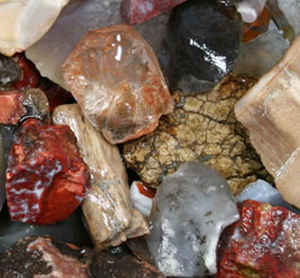
Vermont Symbols
Vermont State Rocks
Granite / Marble / Slate

Adopted on May 28, 1992
Vermont's complex geology has led to the development of a diverse and economically healthy minerals industry which began in Vermont over 200 years ago. Because three of Vermont's rocks are equally important to the state's economy, all three - granite, marble and slate - were formally recognized as State Rocks by Act No. 221 of 1992. When Governor Howard Dean signed House Bill No. 678, Vermont gained an official state gem, an official state mineral, and three official rocks.
There was once more than 700 quarries in Vermont that mined marble, slate, and granite. Of those only about 180 are still being used today.
Vermont State Rocks: Granite / Marble / Slate
Vermont's complex geology has led to the development of a diverse and economically healthy minerals industry which began in Vermont over 200 years ago. Because three of Vermont's rocks are equally important to the state's economy, all three - granite, marble and slate - were formally recognized as State Rocks by Act No. 221 of 1992.
------- from Office of the Secretary of State,
Vermont Legislative Directory and State Manual,
Biennial Session, 1993-1994, p. 23.
The Rock - Granite
 Granite is an igneous rock found along
the entire length of the eastern part of the state. It is mainly composed of feldspar, quartz and mica. The granite from Barre is world-famous, and
the Westmore-Morse Quarry in Barre is the world's largest monumental granite quarry. Vermont granite is exported to many states and countries for use
as building stone and is prominent in the Vermont State Capitol.
Granite is an igneous rock found along
the entire length of the eastern part of the state. It is mainly composed of feldspar, quartz and mica. The granite from Barre is world-famous, and
the Westmore-Morse Quarry in Barre is the world's largest monumental granite quarry. Vermont granite is exported to many states and countries for use
as building stone and is prominent in the Vermont State Capitol.
------- from Office of the Secretary of State,
Vermont Legislative Directory and State Manual,
Biennial Session, 1993-1994, p. 23.
Granite is an igneous rock, which means that at one time during it's development, it was melted like volcanic lava.
Unlike molten lava however, it was unable to escape to the surface. It remained trapped, below ground where it slowly cooled and crystallized, resulting in a very uniform speckled stone that can range in colors from black and grey, to pink and blue, brown and red.
Granite is a light-colored igneous rock with grains large enough to be visible with the unaided eye. It forms from the slow crystallization of magma below Earth's surface. Granite is composed mainly of quartz and feldspar with minor amounts of mica, amphiboles and other minerals. This mineral composition usually gives granite a red, pink, gray or white color with dark mineral grains visible throughout the rock.
- Igneous Rock Type: Intrusive
- Related to: Rhyolite, pegmatite, syenite
- Chemistry: Acidic
- Color: White, pink, orange, gray, black
- Texture: Phaneritic (easy to see crystals)
- Origins: Orogenic Plutons
- Common Minerals: Quartz, feldspars, hornblende and micas
- Accessory Minerals: Tourmaline, phosphates, rare earth oxides, beryl, topaz, zircons, augite, sphene and apatite
- Uses: Building material, decorative counter tops, tiles, tombstones, roads, jewelry, curling stones, marbles
Granite: Barre, Coble hill, and Millstone hill quarries, fine-grained, used in State houses; Black mountain, Dummerston, Windham county; Ascutney mountain, Chester, Cavendish, Pomfret, and Berlin. Extensively quarried at Brunswick, Essex county, known as "Nulhegan granite"; Ryegate, Caledonia county, "Blue mountain granite"; Victory, Essex county; Browngington and Derby, Orleans county; and Woodbury, Washington county.
Among the most popular, the hardest, and the oldest of geosymbols, granite is an official symbol of New Hampshire, Massachusetts, North Carolina, South Carolina, Vermont, and Wisconsin.
Granite has "chunks" of other rock mixed in kind of like a chocolate chip cookie with M & Ms. You'll typically find quartz, feldspar, mica, and hornblende folded into it. Granite is commonly used as a building and decorative stone.
The Rock - Marble
 Marble, a metamorphic rock composed of the
mineral calcite, can generally be found in southwestern Vermont. The marble quarry in Danby is the world's largest underground quarry, covering twenty
acres. Vermont marble ranges in color from pure white to black. It has been used in building Radio City Music Hall, the National Art Gallery, the Jefferson
Memorial and the Vermont State Capitol.
Marble, a metamorphic rock composed of the
mineral calcite, can generally be found in southwestern Vermont. The marble quarry in Danby is the world's largest underground quarry, covering twenty
acres. Vermont marble ranges in color from pure white to black. It has been used in building Radio City Music Hall, the National Art Gallery, the Jefferson
Memorial and the Vermont State Capitol.
------- from Office of the Secretary of State,
Vermont Legislative Directory and State Manual,
Biennial Session, 1993-1994, p. 23.
Marble is a metamorphic rock resulting from the heating of limestone or dolostone. The heating may be regional due to the subduction of a limestone
or may be the result of contact metamorphism where a magma intrudes into a limestone, resulting in partial melting.
Most marbles preserve the impurities and layering of their source limestones as swirls and patterns in the resulting marble, sometimes resulting in
valuable building stones. However, any fossils and textures of the original limestone are completely destroyed by the metamorphism.
Marbles that came from very pure limestone are white.
Note that marble has several properties in common with the calcite or (more rarely) dolomite which are its primary components. Marbles are highly susceptible
to acid etching, will decompose under contact with even a weak acid, and will vigorously effervesce in the presence of a strong one such as muriatic
acid. Marble is also relatively soft, having a Mohs hardness of 3, indicating that it is easily scratched by most materials including common metal
utensils.
Marble:
- Vermont marble; extensive quarries on western side of Green mountains, in Addison, Bennington, and Rutland counties. Most noted quarries in towns of Middlebury, Sudbury, Brandon, Pittsford (several quarries), Rutland (a dozen or more quarries), (a) Clarendon, Wallingford, Tinmouth, Danby, Dorset, and Arlington- a belt 65 miles long, Vermont Italian marble from Dorset. Most extensive quarries in Rutland, Shelburne, Addition county; at Swanton, Franklin county, dove-colored marbles.
- Winooski marble, worked to a limited extent in northwest part of State- Addison, Chittenden, and Franklin counties; also, localities at Mallett's bay, Colchester, near Burlington, and to Swanton.
- Plymouth marble, Plymouth, Windsor county, a variegated marble.
- Isle la Motte marble, Isle la Motte, Lake Champlain; and in Champlain valley, a black marble.
The Rock Slate
 Slate is a metamorphic rock found in southwestern
Vermont. It is formed by the compaction and heating of clay, silt or mud. Vermont slate varies in color from red, green, black and purple. Because
it splits into thin slabs, slate is used for roofing shingles, sidewalks and floor tiles.
Slate is a metamorphic rock found in southwestern
Vermont. It is formed by the compaction and heating of clay, silt or mud. Vermont slate varies in color from red, green, black and purple. Because
it splits into thin slabs, slate is used for roofing shingles, sidewalks and floor tiles.
------- from Office of the Secretary of State,
Vermont Legislative Directory and State Manual,
Biennial Session, 1993-1994, p. 23.
Slate is a low grade metamorphic rock with a fine grain. Slate often has a gray color and may be split into parallel layers. The precursor rock
is generally a shale or siltstone.
Slate is used as roofing, as the flat beds of billiard tables, and historically had many other uses since replaced (such as school blackboards).
Slate: Three ranges of roofing slate:
- Eastern, clay slate near Connecticut river, from Massachusetts line to Essex county; found in Guilford, Windham county; Thetford, Orange county; Waterford, Caledonia county; and other localities and small quarries.
- Middle range of clay slate extends from Memphremagog lake to Barnard slate quarries in Northfield, Montpelier, and elsewhere of uniform shade and black.
- Western Vermont slate quarried largely in Castleton; also in Fairhaven, Poultney, Wells, and Pawlet, Rutland county; generally of a dark purple color, with occasional blotches of green; very compact and fissile. Large quarries near West Castleton, Hydeville, Scotch hill, and Fairhaven.
Vermont Law
The law designating the rocks marble, granite and slate as the official Vermont state rocks is found in the Vermont Statutes Annotated, Title 1, Chapter 11, Section 507.
TITLE ONE. GENERAL PROVISIONS
CHAPTER 11. FLAG, INSIGNIA, SEAL, ETC.
1 V.S.A. § 507 (2012)
§ 507. State rocks
The state rocks shall be marble, granite and slate.
HISTORY: Added 1991, No. 221 (Adj. Sess), § 2, eff. May 28, 1992.
Minerals, & Gems

Gemstone, Minerals, Rocks






